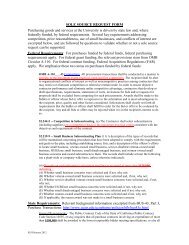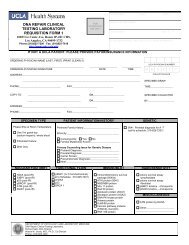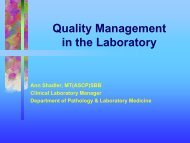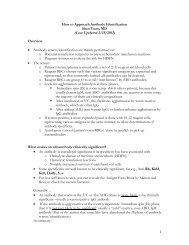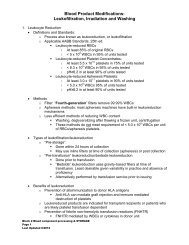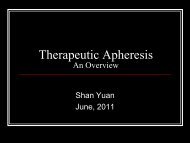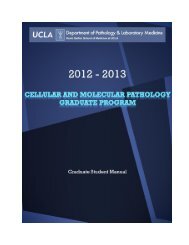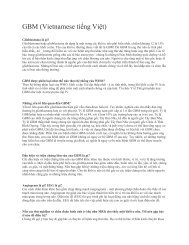TRANSFUSION MEDICINE - the UCLA Department of Pathology ...
TRANSFUSION MEDICINE - the UCLA Department of Pathology ...
TRANSFUSION MEDICINE - the UCLA Department of Pathology ...
You also want an ePaper? Increase the reach of your titles
YUMPU automatically turns print PDFs into web optimized ePapers that Google loves.
on discovery that cefotetan and cefazolin were administered prophylactically forsurgery. To evaluate for possible DIIHA, <strong>the</strong> patient’s serum and eluate were sentto <strong>the</strong> American Red Cross Reference Laboratory (Pomona, CA) with <strong>the</strong> followingresults: The patient’s undiluted serum caused complete hemolysis <strong>of</strong> cefotetan-coatedRBCs; a 1:100 dilution <strong>of</strong> serum strongly agglutinated cefotetan-coated RBCs; <strong>the</strong>eluate also reacted with cefotetan-coated RBCs; all test results <strong>of</strong> non–drug-coatedRBCs were negative; and parallel test results for cefazolin drug-dependent antibodieswere negative. The findings confirmed <strong>the</strong> diagnosis <strong>of</strong> DIIHA due to cefotetan.Fur<strong>the</strong>rmore, <strong>the</strong> in vitro lysis <strong>of</strong> cefotetan-coated RBCs supported <strong>the</strong> suspicion thatintravascular hemolysis had occurred in vivo. Cefotetan DIIHA typically presentswith IgG-mediated extravascular hemolysis, which <strong>the</strong> patient clearly had, basedon <strong>the</strong> positive IgG, unconjugated hyperbilirubinemia, and <strong>the</strong> microspherocyteson <strong>the</strong> peripheral smear. Occasionally, cefotetan DIIHA involves complementmediatedintravascular hemolysis producing a DAT positive for C3. 3 The evidence<strong>of</strong> intravascular hemolysis in <strong>the</strong> patient included hemoglobinemia, nearly absenthaptoglobin, and a very high lactate dehydrogenase level. Although C3 was notdetected in <strong>the</strong> patient’s DAT, <strong>the</strong> authors suspect that this was due to total hemolysis<strong>of</strong> <strong>the</strong> complement-coated RBCs in vivo.transfusion medicineTM 11-4© ASCP 2011Despite <strong>the</strong> patient’s severe anemia, she recovered after transfusion <strong>of</strong> several units <strong>of</strong>RBCs and was discharged in stable condition. After <strong>the</strong> diagnosis <strong>of</strong> cefotetan DIIHAwas confirmed, she was advised to avoid cefotetan, and her drug allergy list wasupdated.REFERENCES1. Petz L, Garratty G. Immune HemolyticAnemia. 2nd ed. Philadelphia, PA:Churchill Livingston: 2004.2. Berentsen S, Beiske K, Tjønnfjord G.Primary chronic cold agglutinin disease: anupdate on pathogenesis, clinical featuresand <strong>the</strong>rapy. Hematology. 2007;12(5):361–370.3. Ogose T, Wakata Y, Kaneko M, et al.A case <strong>of</strong> recurrent paroxysmal coldhemoglobinuria with <strong>the</strong> differenttemperature thresholds <strong>of</strong> Donath-Landsteiner antibodies. J Pediatr HematolOncol. 2007;29(10):716-719.4. Viraghavan R, Chakravarty A, Soreth J.Cefotetan-induced haemolytic anaemia. Areview <strong>of</strong> 85 cases. Adv Drug React ToxicolRev. 2002;21:101-107.5. Garratty G. Drug-induced immunehemolytic anemia. Hematology Am SocHematol Educ Program. 2009:73-79.6. Salama A. Drug-induced immunehemolytic anemia. Expert Opin Drug Saf.2009;8(1):73-79.7. Garratty G, Arndt PA. An update ondrug-induced immune hemolytic anemia.Immunohematology. 2007;23(3):105-119.8. Johnson ST, Fueger JT, Gottschall JL.One center’s experience: <strong>the</strong> serologyand drugs associated with drug-inducedimmune hemolytic anemia-a new paradigm.Transfusion. 2007;47(4):697-702.9. Arndt PA, Garratty G. The changingspectrum <strong>of</strong> drug-induced immunehemolytic anemia. Semin Hematol.2005;42(3):137-144.10. Garratty G. Drug-induced immunehemolytic anemia. Clin Adv Hematol Oncol.2010;8(2):98-101.11. Arepally GM, Ortel TL. Heparin-inducedthrombocytopenia. Annu Rev Med.2010;61:77-90.12. Aster RH, Curtis BR, McFarland JG, et al.Drug-induced immune thrombocytopenia:pathogenesis, diagnosis, and management.J Thomb Haemost. 2009;7(6):911-918.13. Aster RH, Bougie, DW. Drug-inducedimmune thrombocytopenia. N Engl J Med.2007;357(6):580-587.49





